

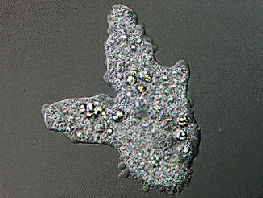
 Copyright © Michael Richmond.
This work is licensed under a Creative Commons License.
Copyright © Michael Richmond.
This work is licensed under a Creative Commons License.
Can we find any trace of extraterrestrial life? And, if we do happen to discover another civilization, can we communicate with them?
We're pretty sure that all the familiar life forms on Earth are related.



Why? Because they share a common biochemical design, and, more particularly, because they share DNA (DeoxyriboNucleic Acid).

Figure taken from the Howe High School biology course
If we are interested in life beyond the Earth, then we have to go elsewhere to find it ....
.... or do we?
Every year, millions of small meteorites fall onto the Earth. Might there were some tiny alien life hitching a ride aboard the meteorite? Scientists have certainly looked.
One class of meteorites, carbondaceous chondrites, has small nodules of darkish material:

These inclusions contain a very interesting mixture of materials which we believe were formed in the proto-solar nebula of gas and dust. The Encyclopedia of Astrobiology, Astronomy, and Spaceflight" describes them thus:
A rare type of stony meteorite which contains large amounts of the magnesium-rich minerals olivine and serpentine and a variety of organic compounds, including amino acids. Although fewer than 100 carbonaceous chondrites are known, they provide a great deal of information about the origin of the Sun and planets, and even of life itself (see organic matter, in meteorites).Carbonaceous chondrites are the most primitive and unaltered type of meteorite known, with an elemental composition probably similar to that of the nebula from which the Solar System formed. In addition to silicates, oxides, and sulfides, they contain, most distinctively, water or minerals that have been altered in the presence of water, together with large amounts of carbon, including organic compounds. The most pristine carbonaceous chondrites have never been heated above 50°C. Different groups of carbonaceous chondrites have been identified that came from parent bodies in different parts of the solar nebula.
There have been several instances in which meteorites have been suspected of harboring evidence of some kind of life.

These claims were shown to be unjustified after several years of further study.
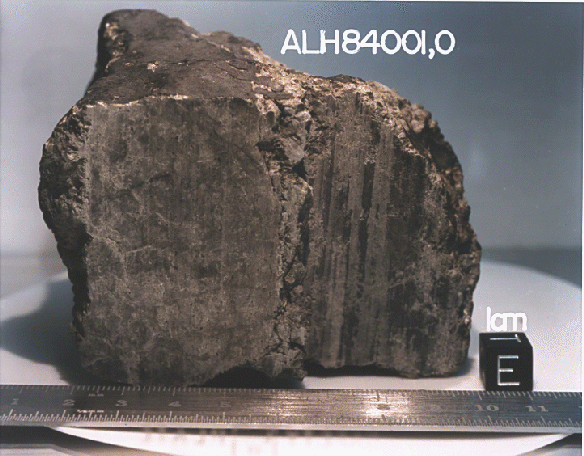
made headlines in 1996 when a team of scientists claimed to see in it evidence for microbacterial life.

This meteorite has globules of carbonate-rich material which, when examined at very high magnification, show structures which some scientists interpret to be fossils of very, very small creatures:

However, after almost a decade of further analysis, the majority of scientists in the field conclude that these traces were created by "non-biogenic processes" (i.e. ordinary chemistry, without any lifeforms).
Strike one. No extraterrestrial life on Earth so far, despite frequent alerts from the Weekly World News.
Okay, so we can't find it on Earth. But Earth isn't the only planet in the Solar System. Let's go through the list:
The most promising places are Mars, Europa and Titan. Let's look briefly at each one.
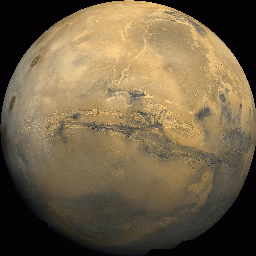
Mars has been a focus of space missions, both American (17 attempts) and Russian (19 attempts), as well as European (1) and Japanese (1).
We have maps of Mars from several orbiters, and information on the surface from five landers:

There were especially sophisticated experiments to search for evidence of life aboard the Viking landers. The results caused a bit of a stir at first, but are currently interpreted as lacking any evidence for biological processes in the surface material at the Viking lander sites.
But keep watching -- there are more missions to Mars planned in the near future.
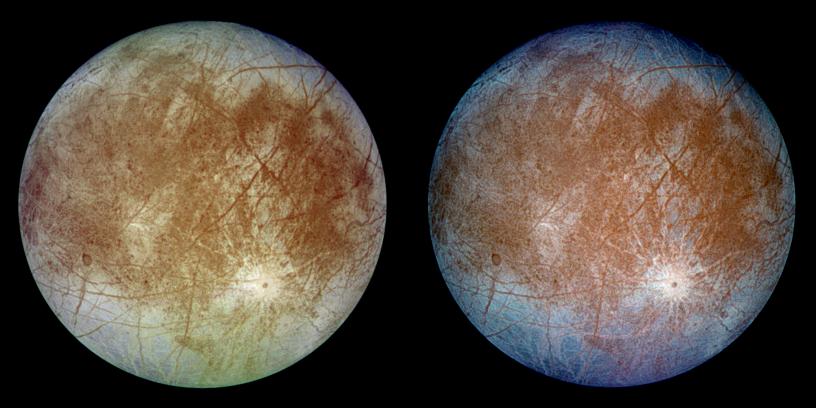
Europa is the second-innermost of the four large satellites of Jupiter. It is a curiously smooth moon: few features rise more than 300 meters above the mean level, or fall more than 300 meters below the mean level. This (and other evidence) suggests that the surface is a frozen layer of slushy material. Much of this slush is likely to be water ice.
Far beneath the surface, the temperature rises due to tidal heating by Jupiter.
Tidal heating? Europa's orbit is nearly a perfect circle around Jupiter. Europa itself is nearly a perfect sphere; but since Jupiter pulls a bit more strongly on the side close to Jupiter, it gets stretched out a bit, like an egg, with the pointed end facing towards Jupiter. Now, if that was the entire story, there would be no heating. However, the gravitational pull of the other large moons tugs it a bit closer or a bit farther away at times, and causes the egg to rotate slightly so that it doesn't point directly at Jupiter. The change in the gravitational forces on Europa as it shifts slightly and rotates slightly "squeeze" its interior, depositing a large amount of heat.
It is possible that the icy surface covers a giant layer of liquid water, some 20 or 50 or 100 km below the crust. There are already several proposals to send spacecraft to Europa to investigate -- though of course it's not very easy to dig down tens of kilometers ...
Oh, one more note: Jupiter has very strong magnetic fields which trap energetic particles. The magnetic fields extend far beyond the visible extent of the planet, encompassing Europa (and all the other Galilean satellites). These very energetic particles would quickly kill an unshielded human, and slowly degrade the electronics aboard a space probe ....
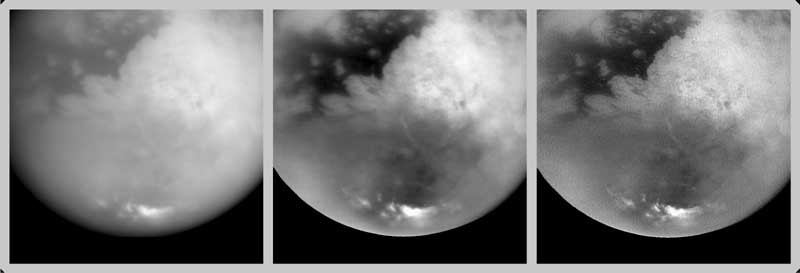
Titan is the largest moon of Saturn, visible through even a small telescope. It is unique among moons in our Solar System in having a thick atmosphere, one even thicker than Earth's. The atmosphere is mostly nitrogen -- like Earth's -- but contains trace amounts of interesting organic molecules like methane and ethane. The combination of (very cold) temperature and high pressure at its surface provide conditions under which ethane (and similar molecules?) might be liquid. Scientists and science fiction writers have speculated that there could be liquid oceans covering portions of Titan's surface.
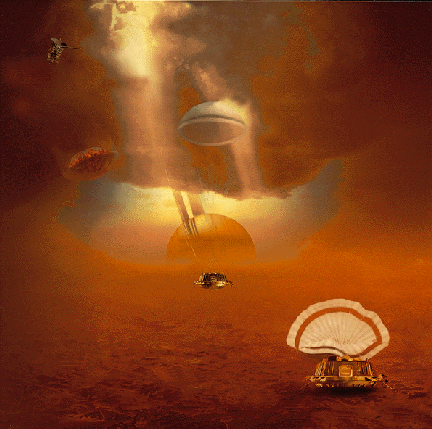
The Cassini spacecraft is currently in orbit around Saturn. In just a few months, it will release the Huygens probe, which will float downwards through the atmosphere of Titan recording information and taking pictures. If all goes well, it may even land and transmit information about the surface.
At the moment, though, we still know very little about the conditions or composition of materials at the surface ...
Okay, so we haven't found any extraterrestrial life within our Solar System. Can we look at other stellar systems?
Well, the topic of finding planets around other stellar systems would be a good first step. Some earlier lectures do exactly that ....
We can find evidence for planets orbiting other stars ... but can we find evidence for LIFE on those planets? Perhaps we can, depending on what we want to count as "evidence of life".
Earth's current atmosphere is very different: mostly molecular nitrogen and molecular oxygen. Why did the composition change to this oxygen-rich form? Because of life:
Photosynthesis produces molecular oxygen
We might then conclude that if we see evidence for an oxygen-rich, earth-like atmosphere around some extrasolar planet, then there might be a similar process involving life on that planet.
So, how could we measure the chemical composition of some distant planet's atmosphere? We have ALREADY done this, in a very coarse way. The paper Detection of an Extrasolar Planet Atmosphere , published in 2002, describes observations of the star HD 209458 as its planet passes in front of it. Scientists broke the starlight into a spectrum and looked very, very, very carefully at the depth of some sodium absorption lines as the planet moved in front of the star....
If the planet had no atmosphere, the mixture of wavelengths would remain the same, before and during the transit:

But if the planet did have an atmosphere, it might absorb some wavelengths more than others -- in a TINY FRACTION of all the starlight reaching us. That would mean teeny, tiny effects on the spectrum we measure.
Here are the observations: judge for yourself whether you see a difference during transit (to left of dotted lines) versus outside of transit (to right of dotted lines):

This is only one portion of the spectral analysis.
Please read the whole paper for the full story.
The only line which was strong enough to test this way in HD 209458 was atomic sodium. This doesn't really bear on the question of life on that planet, but it gives us some hope that we might be able to apply this technique in the future. In fact, NASA is considering a mission to study extrasolar planets and their atmospheres ...
If life should not only arise on some extrasolar planet, but eventual develop an intelligence and a technology like ours, it might accidentally -- or purposefully -- make its presence known by the very unnatural radio signals it broadcasts. There are natural sources of radio waves, of course, but human radio transmissions stand out like a sore thumb ... IF one happens to be looking for them.
Since radio waves travel at the speed of light, they can travel from one star to another within a human lifetime. Many human transmitters tend to send signals in a very wide pattern, covering large swathes of space. In fact, the Earth is now surrounded by a sphere of radio noise which is expanding at the speed of light:

Q: How large is the "bubble" of radio signals
around the Earth today?
Q: How many nearby stars are within this "bubble"?
Some astronomers here on Earth are searching for such radio signals coming from other stars, in an effort referred to as the Search for ExtraTerrestrial Intelligence (SETI).
Construction has recently begun on the Allen Telescope Array in Hat Creek, California. It will eventually have 350 dishes.

The Arecibo radio telescope is used for many different astronomical research projects. Project Phoenix "eavesdrops" on all these observations and checks them for artificial signals.
So far, no convincing evidence of other civilizations has come from any of these radio searches; but people are still trying.
Of course, one might ask, "Is all this effort really worth it? Just how many other civilizations might there be in our Galaxy?"
If we are the only civilization in the Milky Way Galaxy, then it doesn't make sense to put effort into SETI: there just wouldn't be anyone else out there. On the other hand, if there were another civilization on a planet around every other star in our galaxy, there would be, well, billions and billions of opportunities for making contact. Moreover, some of those alien worlds might be "only" 10 or 20 light years away.
That's a pretty big range; is there any way to figure out what the true number of civilizations might be?
Yes and no. Decades ago, Frank Drake came up with a way to approach this question mathematically: he derived what is now called the Drake Equation. Here's the version of his famous Drake Equation you can find in your textbook (there are many variations):
N = N* fp nlz fl fi fS
where
N* = number of stars in the Milky Way Galaxy
fp = fraction of stars with planets
nlz = number of planets per star which lie in the "life zone"
for a long time
fl = fraction of suitable planets upon which life evolves
fi = fraction of life which become intelligent
fS = fraction of star's life for which intelligent life continues
N = number of communicative civilizations in our galaxy
We have some reasonable order-of-magnitude estimates for the first three parameters in this equation, but nothing better than wild-eyed guesses for the final three values. That means, unfortunately, that what you get out of this equation is really what you choose to put into it ...
Note that the DISTANCE to the closest civilization depends strongly on the number of civilizations in our galaxy. If you want a challenge, try this:
Q: Suppose the Milky Way Galaxy is a disk,
75,000 light years across.
If there are 10 civilizations, spaced
uniformly through this disk, what is the
typical distance between them?
If there are 1,000,000 civilizations,
uniformly through this disk, what is the
typical distance between them?
Remember that radio signals travel at the speed of light. Suppose that we were to discover an alien world orbiting the star Vega, one of the closest to the Sun.
Q: How long would it take to send a message to Vega?
How long would it take a reply to return?
How many times could you ask a question and receive
a reply before you died?
 Copyright © Michael Richmond.
This work is licensed under a Creative Commons License.
Copyright © Michael Richmond.
This work is licensed under a Creative Commons License.